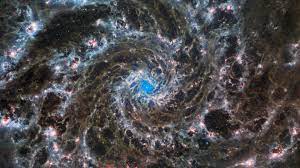The James Webb Space Telescope took this picture of the centre of M74, also known as the Phantom Galaxy.
Webb’s sharp eyesight has shown fine threads of gas and dust in the grandiose spiral arms that stretch out from the centre of this picture.
The absence of gas in the nuclear region also makes it easy to see the star cluster at the centre of the galaxy. ESA/Webb, NASA/CSA, J. Lee, and the PHANGS-JWST Team deserve the credit.
Incredible new pictures of the beautiful Phantom Galaxy, M74, show how powerful it is when multiple space observatories work together to look at the same thing in different wavelengths. In this case, data from the Hubble Space Telescope and the James Webb Space Telescope work together to give a full picture of the galaxy.
The Phantom Galaxy is in the constellation Pisces, which is about 32 million light-years away from Earth. It is almost directly in front of Earth. This, along with its clearly defined spiral arms, makes it a favourite target for astronomers who study how spiral galaxies form and how they are put together.
The power of space observatories working together in different wavelengths is shown in new pictures of the Phantom Galaxy, M74.
The image shows the galaxy as seen by the Hubble Space Telescope. It shows the older, redder stars in the centre, the younger, bluer stars in the spiral arms, and the most active star formation in the red bubbles of H II regions.
It shows the huge amounts of gas and dust in the arms of the galaxy and the dense cluster of stars at its centre. This “grand design” spiral galaxy is shown in a truly unique way in the combined image of M74.
The type of spiral galaxy that M74 is is called a “grand design spiral.” This means that its spiral arms are big and clear, unlike the structure of some spiral galaxies, which is patchy and ragged.
Read Also: Cartwheel Galaxy is shown with stunning detail by the James Webb Space Telescope.
Webb’s clear vision has shown that the grand spiral arms of M74, which go out from the centre of the image, are made up of fine threads of gas and dust. The lack of gas in the nuclear region also makes it easy to see the star cluster at the centre of the galaxy.











